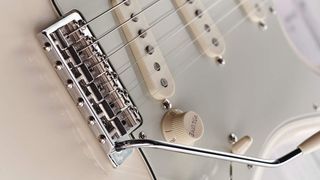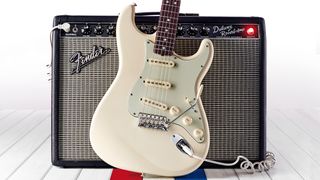Whichever way you spin it, there are really only three ways to present a new version of a decades-old classic - as a period- correct replica, a modern updated interpretation, or as something that sits somewhere in-between.
We’ve seen numerous Fender USA line-ups since the late 80s, but today’s ranges are trimmed down and much more focused. And, in this ongoing rejiggery, 2018 sees another significant change. It’s bye-bye to the American Vintage series, which was launched back in 2012, and hello to the new American Originals.
The American Vintage models were year-specific clones – or, as close as is possible with a modern build... These new Originals, however, aim for a ‘Best of Decade’ vibe. So, for the 50s we get a Strat, Tele and P-bass; for the swinging 60s we have that trio in their ‘grown-up’ specification plus, obviously, a Jazzmaster, Jaguar and Jazz bass. The 70s - hardly Fender’s golden decade - offers us just a lone, block-inlaid Jazz bass.
Meanwhile, southpaws aren’t forgotten with a trio of guitars - 50s and 60s Strats augmented by a 50s Tele.
Price-wise the new Originals sit between the slightly lower-priced American Professionals and the only slightly higher priced remaining American Vintages starting at £1,549 for the 50s Tele, rising to £1,649 for the bound 60s Tele - the basses are slightly more dear, starting at £1,699. Today we’re looking at the reworked Strat.
Build
The same ‘fixed’ vintage-style is applied to this Olympic White Stratocaster within the broad changes of the new decade. So it’s alder bodied with a ‘round-laminate’ rosewood fingerboard that was implemented in mid-1962.
Unlike the conventional ‘slab’ rosewood ’board that was seen on Fender necks from the late 50s, the round-lam was curved to match pretty much the fingerboard radius. Early examples, of which this seems to emulate, saw a thicker piece of rosewood which became thinner during 1963.
The neck profile here is classed as a ‘thick 60s C’ and, like the 50s model, the modern radius fingerboard boasts those slightly higher frets, which, without the finish build-up of our Tele, actually feel a little smaller and measure approximately 2.09mm wide and 1.1mm high.

The ‘narrow’ spaced pearloid dots at the 12th fret give us another period indicator – they changed from opaque cream-coloured ‘clay’ in early 1965, the narrow spacing having been changed in mid-63.
Again in a mid-60s style we get Pure Vintage ’65 Gray-Bottom single coils on an 11-screw mint-green pickguard with aged white controls. Meanwhile, a concession to modernism is the second, lowest, tone control, which originally would have been for the middle pickup, but here works on both the middle and bridge pickups.
Another modern inclusion is the ubiquitous five-way lever switch, which didn’t actually replace the original three-way switch on the Stratocaster until 1977. Inside the pots are CTS 250k while the single tone cap, a large ceramic disc type, is valued at 0.1 microfarad as it should be for pre-1970 Strats along with the full-size shielding plate underneath the three-ply scratchplate.
Sounds
Our 60s Strat, like its 50s incarnation, signifies a huge leap in design and manufacture compared to the recently-reviewed Telecaster. We defy anyone who opens a case and sees one of these beauts not to have an ‘OMG’ moment. The guitar that launched thousands of dreams back in the day still impresses 64 years on.
While the neck here trims a little depth and some of the shoulder compared to the Tele, it still gets big enough as you move up. But, as we say so often, a slight dimensional and shape change means a lot to your left hand and this one feels immediately more comfortable over the Tele’s almost industrial feel. That perception, of course, is mirrored by the body shaping and contouring, and again although our sample is slightly heavier than we’d like, it’s a way more comfortable piece.
You’ll find these ‘fixes’ on many Fender Custom Shop models, of course, but while these don’t come with any ageing or relic’ing they are significantly cheaper.
Yet, viewed from a 2018 perspective, it gives Fender’s USA models a rare unity, a vintage nod to the escalating modernism of the Professional and ultra-tweaked and posher Elites. If you hanker after a new USA-made production Fender and want the most vintage-spec possible, this is now it. Vintage-inspired, yes, but with the fixes that many players will embrace.



